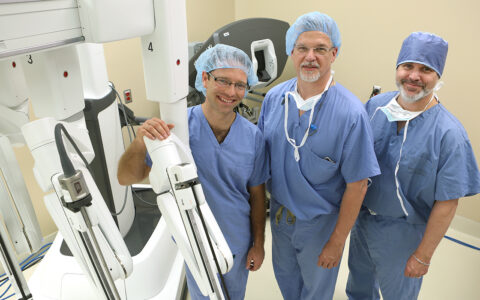In 2015, the FDA approved high-intensity focused ultrasound (HIFU) as a surgical tool for the destruction of prostate tissue (not explicitly for the treatment of prostate cancer). While the current evidence for whole-gland HIFU ablation suggests that its clinical efficacy and adverse events are similar to current definitive therapies, short-term data suggest that focal therapy could reduce the rates of side effects from prostate cancer treatment.
“We know that, historically, we’ve overtreated patients with prostate cancer,” said Kristen Scarpato, M.D., assistant professor of urology at Vanderbilt. “We now appropriately enroll more patients for active surveillance. However, some patients who are not ideal candidates for surveillance may benefit from HIFU. Others may actually be harboring a clinically significant disease that has not yet been diagnosed.”
Scarpato is leading Vanderbilt’s entry into HIFU as an alternative therapy for patients with low-to-intermediate risk (Gleason 3 + 4) prostate cancer. “HIFU fits somewhere between observation and aggressive therapy,” Scarpato explained. “It’s a balance between oncologic control, treatment harms and quality of life.”
“HIFU fits somewhere between observation and aggressive therapy. It’s a balance between oncologic control, treatment harms and quality of life.”
Less Tissue Destruction with HIFU
At the point where HIFU is focused, intense absorption of ultrasound waves creates a rapid temperature increase in the tissue, which destroys cells in the targeted zone. By precisely moving the focal point of each wave, it is possible to destroy a volume of tissue (partial or whole prostate gland) without damaging surrounding tissue.
As with any therapy, there are some side effects with HIFU. Urinary tract infection, scar tissue formation and erectile dysfunction can occur. The rate of cancer recurrence has been shown in some studies to be higher with HIFU and some patients go on to receive a second treatment, including repeat HIFU, radical prostatectomy or radiation.
Because the ultrasound is delivered to the prostate transrectally, the most feared complication is rectal injury due to the high heat moving through the rectum. While there are safety mechanisms in place to monitor and control for rectal temperature, the impact of HIFU on the posterior plane between the rectum and prostate may make second-line therapy after HIFU more challenging.
“Several centers are using HIFU in the salvage setting,” Scarpato said. “I believe it’s a reasonable approach following radiation. The reason I hesitate to use HIFU for salvage therapy, at least initially, is that the tissue has already been subjected to some therapy and the tissue quality is likely compromised; this may be associated with a higher risk of a rectal injury.”
“Several centers are using HIFU in the salvage setting. I believe it’s a reasonable approach following radiation.”
HIFU’s Next Phase in Cancer Treatment
The adoption of HIFU has been slow, in part because the American Urological Association is awaiting comparative outcome evidence before considering it standard care.
Meanwhile, in the United Kingdom, the Partial prostate Ablation versus Radical prosTatectomy (PART) study is comparing radical prostatectomy and partial gland ablation (using HIFU) of prostates in men with unilateral, intermediate-risk prostate cancer. This is the first Phase 3 study comparing these treatments and will measure QOL and oncological results.
“Hopefully, in the near future, we’ll have meaningful data to support HIFU as a first-line treatment for qualifying patients,” Scarpato said.




